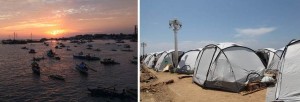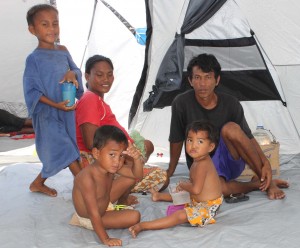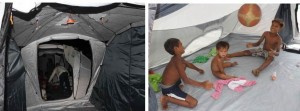
Badjao families spent their first night in Shelter Box tents last night after the Department of Social Welfare and Development (DSWD) in partnership with International Organization for Migration (IOM) completed the installation of tents along Cawa Cawa Boulevard in Zamboanga City. The Rotary Club of Zamboanga facilitated and helped in the installation of the tents.

Popularly known as sea gypsies, Badjao families who live on houseboats, describe that living in tents amid the crisis is, indeed, a new comfy experience for them.
For more than two weeks, Badjao and Samal evacuees from the villages of Rio Hondo and Mariki established their temporary shelters along the coastline of Cawa Cawa Boulevard, a place where they can easily move with the wind and the tide on their small houseboats called “vintas.”
Used tarpaulin sheets, sacks, leatherette, and blankets shielded them from the scorching heat of the sun, but not enough to cover them when heavy rain pours.
Rex Tabao, 35, a Badjao evacuee and a Pantawid Pamilya beneficiary, said that his family had a good sleep all throughout the night. His wife, Indaya, 30 and pregnant with their 8th child would no longer worry waking up every now and then to check on the children.

The family of Rex is among the first Badjao families provided with a tent donated by Shelter Box International. They are from Rio Hondo and were forced to evacuate and set-up their small makeshift tent along the coastline to escape being caught in the crossfire between government troops and Moro National Liberation Front (MNLF)-Misuari faction in Rio Hondo. “The Shelter Box tent is much better than our previous makeshift home,” Rex said.
Rex’s family was among the priority recipients of tents because he has small children and his wife is pregnant. Families with senior citizens, persons with disabilities, lactating mothers, and sick family members were also prioritized.
The DSWD in partnership with the International Organization for Migration (IOM) and Shelter Box International will continue to install 380 Shelter Box tents and 300 laminated plastic sheets for the Badjao and other evacuees in different evacuation centers.
Each tent measures 8 feet in diameter and can accommodate one family. Every tent is equipped with solar lights that will provide lighting at night.
DSWD Secretary Corazon Juliano-Soliman said that these Shelter Box tents will significantly improve the dwelling condition of the Badjao evacuees particularly the women, children, elderly, and persons with disability in anticipation of the rainy days.
“ The Shelter Box tent also serves as a Family-Friendly Space where Badjao families can spend family bonding,” Secretary Soliman added.
For Indaya, the Shelter Box tent is a big help to her family. “Meron na po kaming masisilungan lalo na po pag umuulan (We now have a roof over our heads especially when raining),” Indaya said while feeding her two small kids with a hot porridge mixed with malungay leaves supplied by the DSWD.
Rex credits his wife for keeping their tent clean. “Kailangan po malinis ang aming tent dahil eto po ang tirahan namin hanggang sa susunod na mga araw (We have to keep our tent clean because this will be our home in the coming days),” Rex pointed out.
Rex hopes that the fighting will be over soon so the could already work. Back home in Rio Hondo, Rex and Indaya help each other in earning for a living. Rex would fish while Indaya would sell his catch.
While at the evacuation center, Rex said that he accepts menial jobs from a relative and earns 200 pesos a day that he gives to her wife to buy food for their kids. He recognizes that the DSWD continues to provide them with food.
Like Rex, Risma Jani, 19, said that she, together with her husband, siblings and mother, felt comfortable at the tent. They also felt some privacy as they can eat, lie down, and chat without being watched by other people.
Risma said that they also have a house in Rio Hondo, but for now, they are thankful that they are staying in a real tent which is far better than their makeshift tent made of blankets tied together.
Meanwhile, Lola Kiblatiyan Nurkani, 60, looked contented with her new found home. She was seen cooking their native Badjao delicacy, “Shanglag” or toasted cassava with dried fish, beside their newly-installed Shelter Box tent. Inside their tent, her grandchildren are patiently waiting for her to serve lunch. With temporary homes like these tents, children can freely live normally.

In the other tents, Badjao families were seen already exchanging pleasantries, relaxing, eating or resting. Most children are no longer playing along the streets because they already have safer tents to stay and play. ### Zamboanga City, September 25


